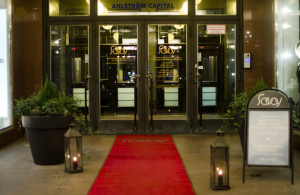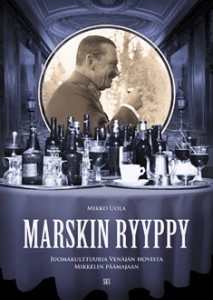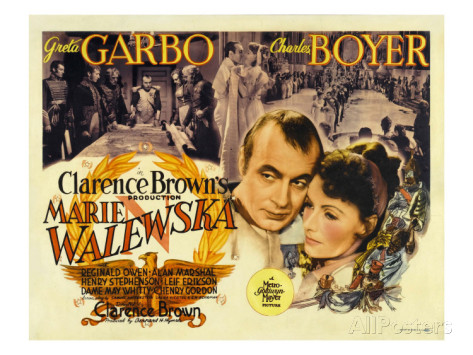Wherever you stroll around Helsinki, you’ll run into reminders of one of Finland’s most famous citizen’s – Marshal Carl Gustaf Emil Mannerheim. Statues in bronze and stone, street signs, photographs and the like all serve to remind the visitor to the city of this quintessential European aristocrat who was over the course of many years the marshal of Finland’s armies, the country’s regent, the architect of its independence and in his final years, president of the republic. The broad street named Mannerheimintie which runs through the centre of Helsinki is named in honor of the Marshal. In front of the city’s main post office is a large equestrian statue of the Marshal while on a bluff overlooking the harbour, on Kalliolinnantie Street, his old home is now the Mannerheim Museum.
One of the many facets of the great man’s life was his well-known interest in fine food and his demanding standards in cuisine and for the restaurants he favored – some of which are still in business. He was also apparently unwavering in his habits and his likes and dislikes with food. The Marshal’s breakfast for example, first served to him by his mother, never changed during his lifetime. “Always he had two soft-boiled eggs in a glass, coffee with milk, and toasted homemade bread with marmalade. And his newspaper. For lunch it was vorschmack. According to legend, his taste for vorschmack was acquired at the Warsaw Officers Club in Poland, where Mannerheim spent some years as an Officer in the Tsarist Russian Army prior to World War One. For this dish, lamb and beef are roasted with onions. When done, the meats and onions are ground together with salted herring and anchovies. The mixture is heated with a little water and garlic until it boils. Then it is allowed to simmer for many hours. Gravy from the roast is added, along with black pepper, and the vorschmack is ready to be served. It comes in a mass, quite like a hash, with smetana (sour cream), the way Mannerheim enjoyed it, and with potatoes.
When the Marshal returned to Finland, he apparently first requested this dish from the restaurant of the Hotel Kämp, but they were not interested in the dish. The Marshal then took the recipe to the Savoy Restaurant in Helsinki, where vorschmack is still one of the favourite dishes on the menu and where it may be enjoyed just as the Marshal enjoyed it. Another of his favorite dish’s was smoked piglet stuffed with buckwheat. Mannerheim’s kitchen staff knew the Marshal’s likes and dislikes. They knew he was fond of fish, but that there were limits, and pike for example was definitely off-limits. Not everyone knew these pitfalls. One of his generals once sent Mannerheim a box of pike packed in ice, and Mannerheim expressed his thanks for the shipment. Later on, another general asked the Marshal if he had found the pike tasty. “Surely it’s enough that I thanked him for the pike. I’m not expected to eat it too, now am I?” Mannerheim apparently responded. The quote is a small part of Finnish history. Morels (highly desirable mushrooms, second only to truffles, but requiring careful preparation as they are poisonous when raw) were banned from the table after the Marshal once found a grain of sand in his creamed morels. “Do I even have to eat all the rocks in the fields of the entire province of Savo before this war is over?” was the Marshal’s reaction.
Mannerheim was famous for organizing banquets and dinner parties, where protocol was strictly followed – with no exceptions. As a Host, he paid special attention to the table settings and to decoration with flowers (as well as to the menu). And in addition to etiquette, of course the most important issue was delicious food. Mannerheim had spent many years in Russia and was influenced by Tsarist St. Petersburg’s versatile international food culture. Dinner was generally started with a Russian style soup, followed with a fish dish, a meat dish, a vegetable dish, dessert and coffee. Mannerheim also appreciated good wine, with his absolute favourite apparently being “Le Cardinal”. The seating order at the dining table was carefully planned and Mannerheim would choose the topics of conversation. No smoking was allowed at the table. During WW2, the war itself was a strictly forbidden subject as mealtimes were generally when the Marshal could relax a little.
One unfailing practice of the Marshal’s was his favorite aperitif of schnapps prior to the meal starting. In the Russian army, a meal included one drink. The glasses were poured chock-full to avoid differences in measuring. Mannerheim adopted the same principle; the glass had to be full and nothing should be spilled when drinking it. This tradition is still connected with the Marshal’s drink. When Mannerheim was asked about the background of the tradition of the chock-full glass, he said it went back to the custom in the Russian army, their Cavalry School and the Chevalier Guards, in whose ranks Mannerheim had served himself. It was a custom in St Petersburg at the end of the 19th century that part of the officers’ salary was paid as drinks: one at breakfast and two at dinner. It was quite natural that everyone wanted the glass as full as possible, as the state was in charge of the costs. This so called “Marskin ryyppy” (Marshal’s Tipple) was made from akavit, dry white vermouth and gin (one litre of Rajamäki aquavit, 2 centilitres of dry French vermouth and 1 centilitre of gin) and has since attained an almost mythical status in Finland.The recipe was developed by the Marshal’s aide-de-camp, Grönvall after the Marshal complained about the bitter taste and low quality of the “tikkuviina”, a schnaps sold at the time by Alkoholiliike (the Finnish Liquor Store) in wartime Finland. After the right mix was found, the drink was first known as Grönvall’s Cocktail. Once it was established as Mannerheim’s favourite, the name changed to Marskin ryyppy.
This aperitif was served in frozen glasses and to pour this schnaps was a delicate task – the drink had to be filled to the brim and rise a millimetre over the brim of glass without a drop being spilt. This needed a steady hand. The drink itself was, according to the Marshal’s established etiquette, drunk sitting down, in three nips and without toasts (the Marshall “disliked babbling”). When Gustaf Adolf, the Crown Prince of Sweden, downed his appetizer in a single go as was customary in Sweden, the Marshal asked the waiter to fill up the glasses again, only to witness the Crown Prince repeat his bottoms-up act. Their is even now a book about the Marshal’s drink – “Marskin Ryyppy” by Miko Uola and published by the Finnish Literature Society – unfortunately for those of us not fluent in Finnish, this book is available in Finnish only. Many stories have been told of the Marshal’s amply full liquor glass. Some people spilled it into their sleeves, others onto the table and some even into their food. Catching someone spilling it into the food on their plate, the Marshal was astonished: “Do you think the food needs to be spiced with vodka or the dressing sauce to be thinned, or is there anything else wrong with the food?” He had no trouble coining up some minor wicked joke.
With the aperitif drunk, Mannerheim started the meal when everyone had food on the plate. After he was done with eating he moved to the round coffee table and everyone stopped eating, whether they had finished or not. After the meal, some of the company were invited to join Marski at the coffee table, where a close-order drill of cognac drinking occasionally took place.The Marshal allowed the cognac served with the coffee to remain in his mouth for eight seconds before swallowing. On one occasion when someone in his party had some water too quickly after his cognac, the Marshal ordered the waiter to take away the balloon glasses and to bring in a new bottle. This time someone else sipped his coffee too hastily. Again, the glasses were collected, and a new bottle was brought to the table. Finally the Marshal said: “Gentlemen, unfortunately I don’t have any cognac better than this last bottle.”
For many years, Marshal Mannerheim carried tremendous responsibilities on his shoulders and meal-times, during the war years in particular, were often the sole carefree moment in his day during which he could forget his worries and relax. For more formal dinners, Mannerheim often had zander (a member of the perch family) included on the menu – this, along with lamb (a dish he had become fond of during his travels in Asia) was one of his favorite dishes. Accordingly, here is the recipe for one of Marshal Mannerheim’s favourite dish’s, Zander Walewska. Now Zander Walewska seems to be a Finnish version of Filets de sole Walewska, an extravagant dish of dover sole topped with sliced lobster and truffles, then covered in a Béchamel sauce, originally created by the great French chef, Escoffier to commemorate the 100th anniversary of the first meeting of Napoléon and the Polish Countess Marie Walewska.
The story goes that after Napoleon’s humiliation of Prussia, on the field of Jena, the French Emperor turned his attention to subduing his Russian foe and marched into Poland in the winter of 1806. Napoléon met Marie on New Year’s Day in 1807, shortly after the Russians had been beaten and brought to the peace table. Napoléon was driving through a blinding snowstorm. His carriage stopped at a small Polish town to change horses. A blond, blue-eyed, teenaged girl, Marie Walewska, came to the carriage and begged for Poland’s independence.
Marie related the meeting in her diary: “Napoléon raised his hat, bent toward me, I don’t know what he said to me then because I was too eager to express what I was feeling. Be welcome, a thousand times welcome to our country. Nothing that we could do would express strongly enough either our admiration for you personally or the pleasure we have in seeing you set foot on the land which expects you to reestablish it…. Napoléon looked at me closely and took a bouquet which happened to be in the carriage, and as he gave it to me he said, “Keep it as a pledge of my good intentions; I hope that we shall see each other in Warsaw and that I shall receive a thank-you from your beautiful mouth.'”
Napoléon saw Marie again a few days later at a ball in Warsaw. When he asked who she was, he learned that the eighteen-year-old girl was the wife of the seventy-year old Polish patriot, Count Walewska. Napoléon developed a sudden passion for Marie and sent her a love letter which was intercepted by Prince Ponitowski, the leader of the Polish liberation movement. Ponitowski and a group of the most influential in Poland begged Marie to use her body as a pawn for Poland’s independence. Marie did her patriotic duty and became Napoléon’s mistress. Napoléon never gave Poland the freedom that he promised, but it didn’t matter any more. Marie was in love and gave him a son (Alexandre Florian Joseph Walewski, who became a a Polish and French diplomat), and continued as his mistress until his death. In September of 1816 after Count Walewski died, Marie married a cousin of Napoléon I’s, Count Philippe Antoine d’Ornano. She died giving birth to her third son in 1817. Her heart was placed in the crypt of the d’Ornano family in Père Lachaise in Paris and her body was brought back to Poland. Their love affair was immortalized in the 1937 film Conquest (also called Marie Walewska) with Greta Garbo as Marie and Charles Boyer as Napoléon.
Zander Walewska – Ingredients
The quantities below should be good for 4 to 5 people.
- Skinless filets of zander (perch), 750 g
- Fish stock
- White wine
- Salt, white pepper
And not forgetting the Sauce:
- Chantarelle mushrooms, 250 g
- Chopped onions, 50 g
- Wheat flour, 2 tbs.
- Butter
- Fish stock
- White wine
- Cream
- Potatoes:
Zander Walewska – Instructions
- Use one kilogramme of boiled potatoes to prepare a mash. Add butter and egg yolk to improve the taste. Season with salt and pepper.
- Place the zander (perch) fillets in an oven dish and season with salt and white pepper. Let the salt soak in for 10 minutes. Pour in the white wine and the fish stock so that the fish fillets become covered.
- Bake the dish in 200 degrees centigrade, until the fish is nearly done.
- Prepare the sauce: use butter to fry the onions and the chanterelle mushrooms, add wheat flour. Add fish stock until its smooth and thick and let the sauce simmer until the flour is absorbed, then add a dash of white wine and some cream.
- Pipe the mashed potato along the edges of an ovenproof serving dish. Lay the zander filets in the middle and coat them with the sauce, then gratinate in the oven. Decorate with fried giant prawn tails and dill.
Now there are a couple of major differences here from the original Filets de sole Walewska recipe. Prawn tails are substituted for lobster tails, chantarelle mushrooms for truffles and perch for sole. That perennial Finnish favorite, dill, replaces the cheese, salt and pepper of the original receipe. Also note the inclusion of mashed potatoes for a border around the dish. Not having easy access to perch, I substituted sole for the Zander Walewska recipe and it came out quite well. I’m going to play around with this recipe and try a few variations, including the original Béchamel sauce. May have to forego the truffles though!
Cooking this dish is not particularly complicated, although if you go back to the original Filets de sole Walewska it does become somewhat more so. Just be careful not to overcook. And enjoy….
Hyvää ruohahalua! (Bon Appetit!)…………Nigel
 Copyright secured by Digiprove © 2014 Alternative Finland
Copyright secured by Digiprove © 2014 Alternative Finland






